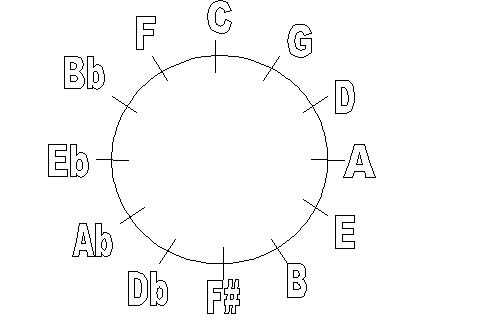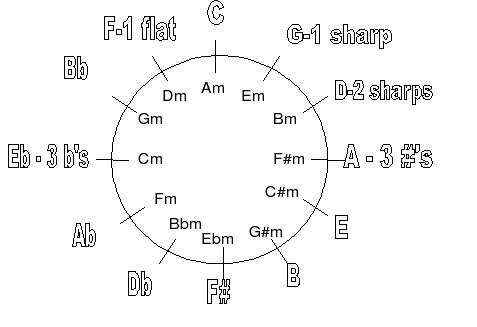Mike Moxcey ©2005
Circle of Fifths
The Circle of Fifths is one of the neatest things you’ll ever see. There are so many different aspects of music theory that drop out from it. To construct it, think of a
clock—round and with 12 notches for each of the 12 different notes.
At the top, midnight, you begin with C. Then you proceed clockwise moving up a fifth (7 frets) for each hour of the clock. Wind players sometimes go around clockwise moving up a fourth (5) frets so all their regular keys shows up on the right hand side of the clock. Whichever way you go, you end up with a circle of notes that are a fifth apart.

Chord Progressions
Many chord progressions fall out of the Circle:
- The basic I-IV-V chord progression is shown as consecutive notes on either side of the root.
- The jazz progression, I-II-V, is found by jumping ahead two hours then moving back.
- The ragtime progression can be found by jumping ahead three or four hours and then coming back through each chord. Sometimes you might want to make the chords minors or sevenths.
- The chords used most often with modal tunes are found by going counter-clockwise two hours.
Just having a handle on these chord progressions makes it wise to memorize the circle of fifths.
Key Signatures
The circle of fifths also tells you the number of sharps or flats in a key signature. Going clockwise, G has one sharp, D has 2, A has three, and so on. Moving backward from C (which has nothing in its key signature), F has one flat, Bb has 2, Eb has three and so on.
Circle with Relative Minors
Some people make copies of the circle of fifths to tape on their instrument when learning chord progressions. Another helpful addition is to put the relative minor keys next to the major ones for easy reference. Put Am next to C, Em next to G, and then follow the original Circle to get the rest of the minors: A-E-B-F#-Db

Reading Music Index


